Physical Address
304 North Cardinal St.
Dorchester Center, MA 02124
Physical Address
304 North Cardinal St.
Dorchester Center, MA 02124
In medieval times, getting an education was hard because books were rare. Only a few could learn. Now, Technology Changed has made learning easy with the internet and online classes. This change could make learning better for everyone.
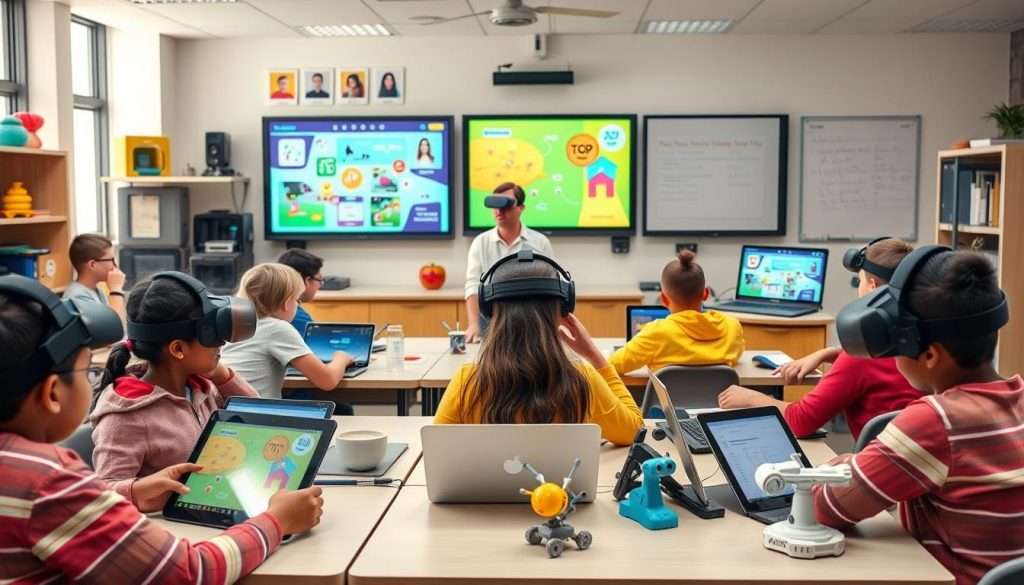
The history of educational technology is filled with innovation and change. It started with the first teaching methods and has grown a lot since then. The 1960s brought in overhead projectors and educational TV. The 1980s saw personal computers become common in schools, changing how we learn.
In 1928, Sidney Pressey created the “teaching machine,” an early version of today’s learning systems. Over time, technology in schools got better and better. The 1980s brought personal computers into classrooms. This led to educational software, interactive lessons, and tests on computers, changing how students learn.
The digital revolution has changed schools a lot. Nowadays, technology has become an important part of education. Schools use digital books, personal devices, and tools for teamwork and virtual experiences. This helps students learn better and get ready for the digital world.
Technology has changed education a lot. It has made learning and teaching different. Now students and teachers can easily access a lot of information. This makes learning fun and personal.
Digital tools have changed classrooms. They make learning more interactive. Technology has also made it possible to learn from home. By 2019, 53% of teachers said their students use digital tools every day. In 2020, 74% of college students studied online.
New tech like apps and virtual reality make learning exciting. Teachers who learn about technology can use it better. They can help students learn in their own way.
| Technology’s Impact on Education | Percentage |
|---|---|
| Teachers believe technology allows them to reinforce and expand on content | 70% |
| Teachers agree that technology can allow students to demonstrate understanding and knowledge in new ways | 79% |
| Teachers believe that technology enhances communication between students and teachers | Over 60% |
| Students who believe digital devices increase their productivity and GPA | 81% |
| Respondents who stated that digital learning resources and tech gadgets are more accessible | 82% |
The impact of technology on education is huge. It has made learning better for everyone. As technology keeps growing, it will keep changing education for the better.
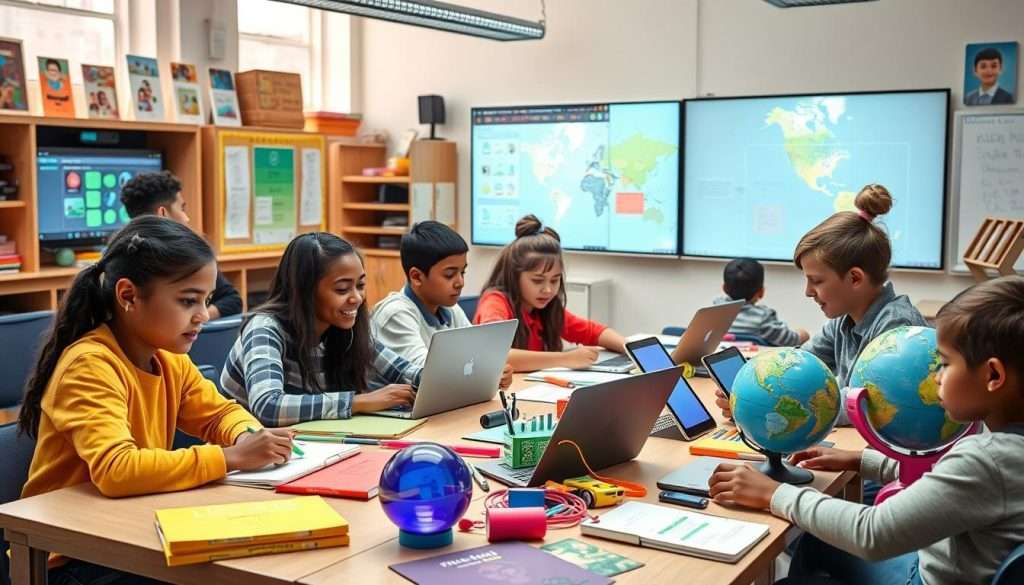
The digital revolution has changed education, bringing new learning platforms. These platforms change how students learn and interact with content. Now, we have Learning Management Systems (LMS) and Virtual Learning Environments (VLEs), making learning more diverse and easy to access.
Learning Management Systems, like Blackboard and Canvas, are key in today’s education. They help organize courses, deliver content, and track grades. This lets teachers focus on teaching, not just paperwork.
Virtual Learning Environments (VLEs) go further, creating online spaces for learning. They use new tech to make virtual classrooms and labs. This way, students can learn together, even when they’re apart.
Mobile devices have led to more mobile learning apps. These apps let students learn anywhere, anytime. They offer interactive books and quizzes, fitting different learning styles.
Digital learning platforms have changed education, making it more accessible and engaging. As tech keeps improving, learning will only get more personalized and immersive.
Mobile devices like smartphones and tablets have changed education a lot. They are now key tools in classrooms, helping both students and teachers a lot.
One big plus of mobile learning is easy access to lots of information. Students can use their devices to research, check facts, and explore different types of content. This helps them learn more than just from books.
Mobile devices also make learning more fun and interactive. Teachers can use apps, simulations, and multimedia to make lessons exciting. This helps students understand complex ideas better and makes them more interested in learning.
Another benefit is how easy it is for students to work together, no matter where they are. They can work on projects, join online discussions, and talk to each other using apps and video calls. This gets them ready for the digital world and teaches them important 21st-century skills.
Mobile technology also makes teachers’ jobs easier. They can grade, track attendance, and talk to parents using their devices. This saves time and lets them focus on teaching better.
As mobile devices become even more important, education will keep changing. Schools can use these tools to give students unique learning experiences, teach them about technology, and prepare them for a world that relies on it.
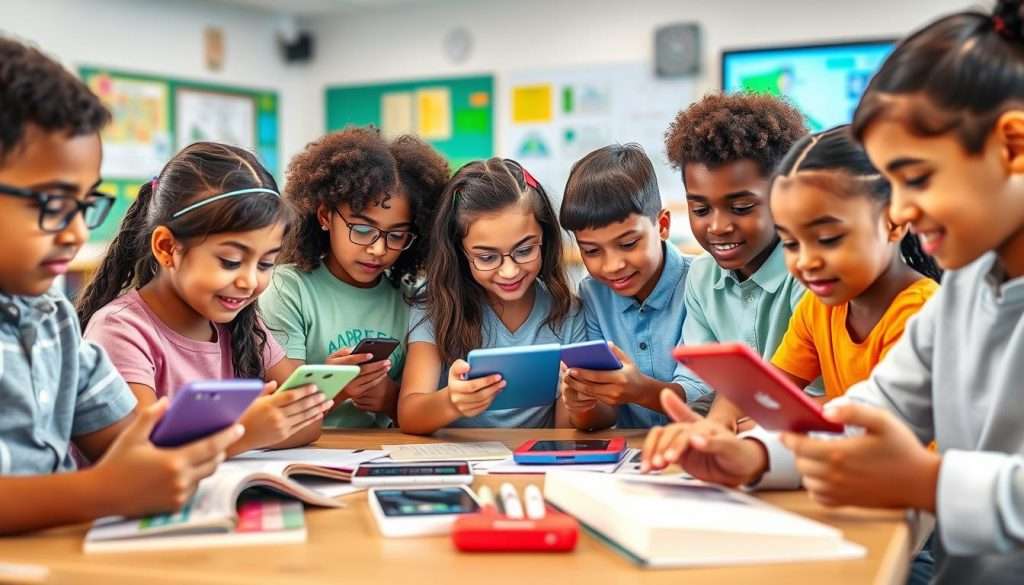
“The integration of mobile technology in education empowers students to become active, self-directed learners, fostering critical thinking and problem-solving skills.”
Interactive whiteboards and smart classrooms have changed how we teach. These tools make learning fun and engaging. They help students learn together and meet different learning needs.
Interactive whiteboards and smart classrooms help teachers and students a lot. They make it easy to show multimedia and lead interactive lessons. These tools support many learning styles, making students more involved and interested.
Research shows that 92% of teachers think technology makes students more engaged. Also, 75% of teachers believe technology improves education. Tools like Samsung’s WAD Series displays offer features like 40 touchpoints and 4K UHD screens. They help all kinds of learners.
It’s important to use interactive whiteboards and smart classrooms with the curriculum. These tools help teachers share lessons easily and teach in different ways. They make learning at home or in a mix of settings better.
Smart boards are becoming more common than old projectors. They make teaching easier and keep students interested. Studies show they can help students do better on tests and learn more.
“Interactive whiteboards and smart classrooms have transformed traditional teaching methods, allowing for dynamic content presentation, interactive lessons, and seamless integration of multimedia resources.”
As big touchscreen displays get cheaper, more schools will use them. This will keep changing how we teach and learn.
Virtual Reality and augmented reality are changing the way students learn. These technologies take learners into rich, interactive worlds. They make complex ideas real and hands-on.
VR headsets let students explore history, science, or cultures in a new way. AR adds digital layers to the real world, making learning fun and clear. These tools are great for students who need extra help, offering learning that fits them.
VR and AR are becoming more popular. By 2050, many people will use these technologies. Harvard’s VR computer science course has reached over three million students worldwide, showing how widely used they are.
Studies show we process visuals much faster than text. This makes VR and AR great for keeping students interested and doing well in school. They help students learn more and think creatively.
VR and AR are also good for learning languages. They offer tools to help with translation and writing. Almost 70% of parents think AR can really improve schools. Companies are spending a lot on these technologies, seeing their big impact.
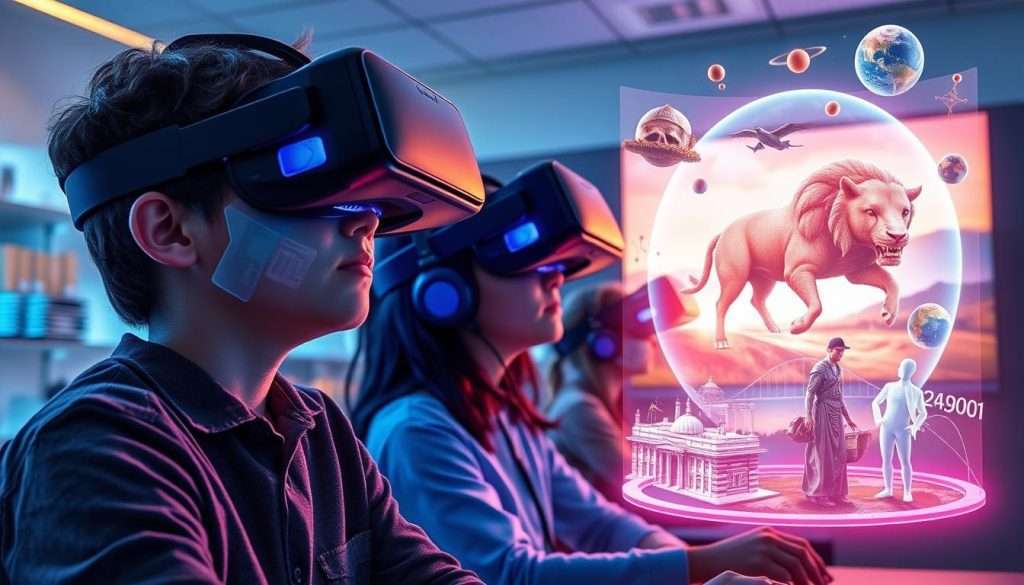
“VR and AR technologies are not just gimmicks – they are transforming the way we approach education, fostering immersive, personalized learning experiences that engage students like never before.”
As education changes, VR and AR will be key. They will help students learn in new, exciting ways. This will open up possibilities for learning that go beyond what we know today.
AI is transforming education by improving teaching methods, personalizing learning, and expanding access to resources. it offers new tools that make learning more personal and help students do their best. AI is making learning paths that fit each student’s needs and abilities.
AI looks at how well students are doing and makes learning plans just for them. These plans help students learn at their own speed. This way, they get better at what they’re doing and stay interested in learning.
AI is bringing new tools to education that make learning more interactive. For example, AI can act like a tutor, giving students feedback and help right away. These tools make learning more efficient and help both students and teachers.
Using AI in education, personalized learning, and adaptive learning technologies is making learning more fun and effective. As AI keeps getting better, the future of learning looks very promising for everyone.
Education has changed a lot thanks to cloud computing. This technology has made it easier to store, access, and share educational resources. It has made learning more collaborative and flexible.
Cloud-based platforms have changed the game for schools. They offer cost-effective ways to manage and share digital educational resources. Students and teachers can easily access materials and work together, no matter where they are.
The use of cloud-based learning has grown a lot lately. Schools like the Grossmont Union High School District in California are moving to cloud solutions. They want better technology interaction in the classroom.
K-12 schools are also adopting cloud backup solutions. They focus on backing up Microsoft 365 and Google Workspace data. This shows how important cloud storage is for data safety, especially against ransomware and natural disasters.
Cloud storage is not just for backup. It also offers immutable storage to protect against tampering. Schools use the cloud for physical security upgrades, like storing surveillance video data. They also ensure AI-based cameras and security technologies stay connected.
The cloud computing market in education was worth $8.13 billion in 2016. It’s expected to hit $98.12 billion by 2031. This growth shows the many benefits of cloud computing in education, like better accessibility, collaboration, cost savings, and scalability.
As more schools use cloud-based learning and digital educational resources, cloud computing’s role in education will grow. It will help create a more dynamic and connected learning environment for everyone.
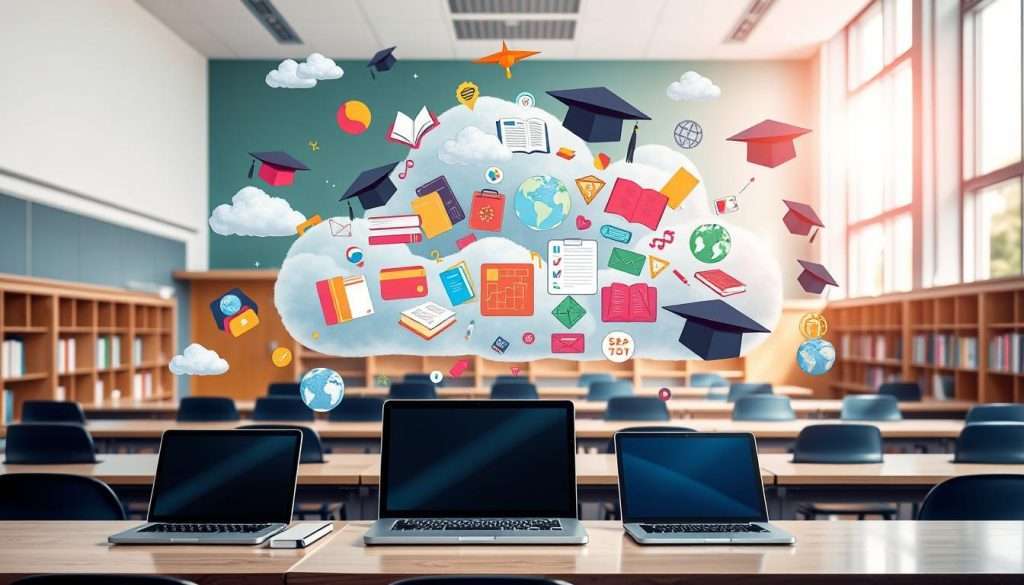
Social media has changed how we talk and work together in schools. Sites like Facebook, Twitter, and Instagram help students learn from each other. They also help teachers connect and share ideas.
Students can work together on projects using social media. They can form groups, share notes, and talk about class topics. This builds a community and teaches teamwork.
A biology teacher used Twitter to get students talking about meiosis. This made learning fun and helped students think critically.
Social media is great for making connections in education. Sites like LinkedIn help students meet professionals in their field. This can lead to jobs or internships.
Teachers can also use social media to work together. They can share ideas and keep up with new teaching methods. This helps everyone improve their teaching skills.
But, using social media in schools comes with challenges. Issues like fake news, bullying, and privacy are big concerns. Still, the good it does for learning is clear. Social media will keep changing how we teach and learn together.
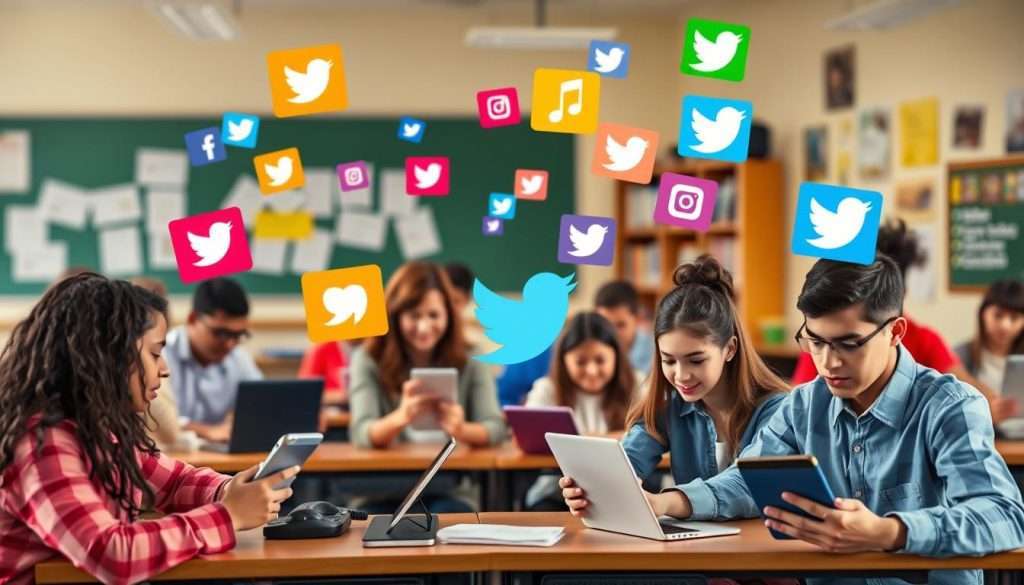
The COVID-19 pandemic has made remote learning and virtual classrooms more popular. These new ways of learning let people study from anywhere, making education more flexible and accessible. Virtual classrooms use video calls, interactive boards, and digital tools to make learning fun and interactive.
MOOCs, or Massive Open Online Courses, have opened education to more people worldwide. They let learners get new skills and qualifications from home. Virtual classrooms also help teachers and students connect better, improving the learning experience and helping students develop social skills.
Technology has helped schools meet the changing needs of students. It has given students the tools to get better at technology and prepare for a future full of innovation. Online education has made learning more accessible. It helps full-time workers, kids who can’t go to school, and people with health or travel issues to learn.
New educational technologies like mobile apps, virtual reality, and collaborative platforms have changed how we teach. As education keeps evolving, virtual classrooms and remote learning will become even more important. They will help make learning accessible, personalized, and ready for the digital age.
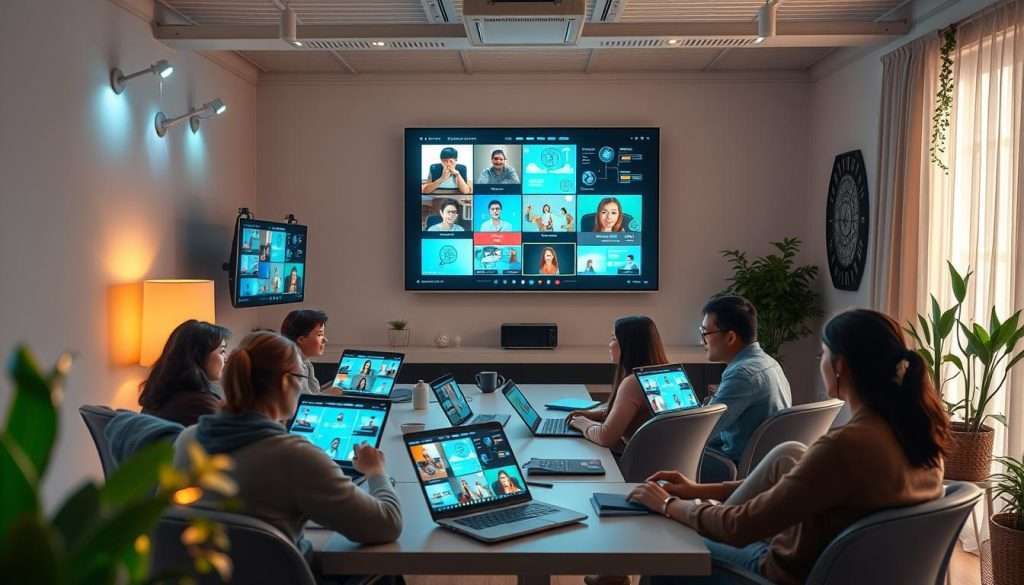
“Virtual classrooms offer flexibility and accessibility, providing students with the opportunity to participate in learning activities regardless of their location, indicating a shift towards a more inclusive learning environment.”
In today’s world, technology has changed education a lot. It makes learning more fun and interactive. Teachers can now use technology to keep students interested and help them learn in different ways.
Things like games, videos, and simulations have made school more exciting. These methods grab students’ attention and help them remember what they learn. Students learn better when they’re involved in the lesson, not just listening.
Technology has also changed how teachers check if students are learning. Digital tools give quick feedback, helping teachers adjust their teaching on the fly. These tools make learning more personal and fun for each student.
Technology helps teachers create a lively learning space. It boosts student engagement, supports interactive learning, and offers precise digital assessment tools. This approach can greatly improve how students learn and prepare them for the future.
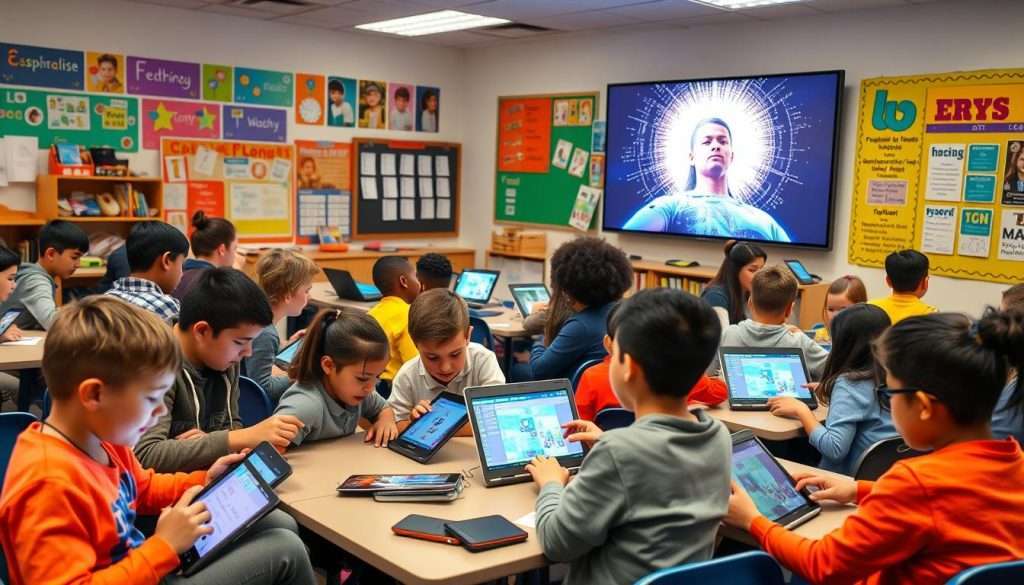
The use of technology has changed teaching methods a lot. Now, teaching is more interactive and focused on the student. Blended learning mixes in-person teaching with online work. This approach allows students to benefit from multiple advantages.
Flipped classrooms use tech to teach outside class. This lets class time be for hands-on, group work. These new ways of teaching help students think critically and learn on their own.
Recent studies show that 63% of K–12 teachers use technology every day, up from 55% in 2016. Teachers are using digital tools like educational apps (58%), social media (41%), and 3D printers (21%) more. Platforms like Kahoot! and ClassDojo are very popular, with over one billion users in 200 countries and 51 million users in 180 countries, respectively.
But, using technology in class also raises some worries. 70% of educators worry that devices distract students, and 25% feel unsure about students’ tech skills. Yet, the benefits of using tech in teaching are clear. 81% of students say digital tools help them do better in school, and 82% find it easier to study with tech.
“Just 25% of teachers are using health and wellness tools, but 75% of them say these tools have proven effective in their classrooms.”
As teachers keep using modern teaching methods and technology-enhanced pedagogy, teaching will keep changing. This will lead to more fun and effective learning for students.
In the modern world, technological skills are essential. Schools are now teaching skills like data analysis, coding, and making digital content. This helps students get ready for the digital future.
Students need to be good with digital tools in class. They should know how to use online tools and work together online. Digital literacy helps them learn without getting stuck on technology issues.
It also teaches them about being safe online. This includes knowing about copyright, plagiarism, and cyberbullying.
The job market is changing fast because of technology. Students need to be ready for a world that’s all about tech. They should learn to think critically, solve problems, and keep learning.
Schools and online places like Khan Academy and Code.org are helping. They offer lessons and tools to help students get ready for the digital world.
By teaching digital literacy, 21st-century skills, and technology competence, schools can prepare students. They become confident, responsible, and ready for the future.
Digital literacy equips students with critical thinking, responsible online behavior, technology proficiency, and career-ready skills, helping them excel academically and navigate daily challenges.
Technology in education has many benefits, but it also has challenges. One big issue is the digital divide. This is when some students don’t have access to technology or fast internet. It affects students from low-income families and underprivileged communities, making it hard for them to learn online.
Another problem is technology integration issues in classrooms. How well technology works depends on how it’s used and if teachers are trained. If it’s not used right or teachers aren’t prepared, it can cause problems and lower learning results.
There’s also worry about overuse of screens and digital devices. Too much time on screens can lead to eye problems, headaches, and less physical activity. This can harm students’ health and how well they do in school.
Concerns about data privacy and security are growing too. Schools and online platforms collect a lot of student data. This raises the risk of data breaches, identity theft, and misuse of personal info.
To overcome these challenges, we need a big plan. We should invest in better technology access, train teachers, and protect student data. By doing this, we can make technology a powerful tool for learning and prepare students for the digital world.
| Challenges and Limitations | Key Considerations |
|---|---|
| Digital Divide | Disparities in access to technology and high-speed internet connectivity, disproportionately impacting low-income and underserved communities. |
| Technology Integration Issues | Effective implementation and alignment with pedagogical goals, requiring ongoing teacher training and support. |
| Overuse of Screens | Potential impact on student well-being, including eye strain, headaches, and reduced physical activity. |
| Data Privacy and Security | Increased risk of data breaches, identity theft, and misuse of sensitive student information. |
By tackling these challenges, we can make technology a powerful tool for learning. It will help prepare students for the digital future.
Technology has changed education, offering new ways for students and teachers to learn. Looking ahead, tech will keep improving, making learning more personal and fun. This will help students get the best education possible.
Technology like digital platforms, augmented reality, and virtual reality is changing education. Artificial intelligence and cloud computing are also playing big roles. These tools can make learning more effective and inclusive, but schools must handle data privacy and connectivity well.
To make technology work in schools, we need a balanced approach. We must consider the needs of students, teachers, and the whole education community. By using technology wisely, we can make learning more engaging and prepare students for the digital world.
Technology has changed education a lot. It provides quick and convenient access to a vast amount of information. It also helps us communicate and work together better.
Teachers now help students learn instead of just teaching. This makes learning more fun and personal.
The first big step was in 1928 with Sidney Pressey’s “teaching machine.” The 1980s brought computers into schools. The 1990s saw the start of the World Wide Web.
By 2000, technology was used in many ways in schools. The early 2000s introduced interactive whiteboards. The 2010s brought portable devices.
Digital learning platforms have changed education a lot. They help manage courses and deliver content. They also keep students engaged.
Systems like Blackboard and Canvas help organize and check work. Virtual Learning Environments create online spaces for learning. Mobile apps let students learn anywhere, anytime.
Mobile devices are very useful in schools. They are as powerful as desktops. They help with many things like checking facts and taking tests.
They support different ways of learning. They also help students talk to each other and find information fast. This makes learning better.
Interactive whiteboards and smart classrooms have changed teaching. They make lessons more interactive and fun. They also make it easy to use multimedia.
They help different learning styles. They make students more involved. This makes lessons better and more engaging.
Artificial Intelligence is changing education. It helps make learning paths for each student. It uses AI to help students learn better.
AI systems give feedback like a human teacher. This makes learning more effective and efficient.
Cloud computing has changed how we use educational resources. It makes it easy to work together, no matter where you are. It’s also cheaper for schools to use.
It helps students and teachers access learning materials from anywhere. This supports learning from home and flexible schedules.
Social media is changing how we talk and work together in education. Sites like Facebook and Twitter help students discuss and share. They also connect with experts.
They help students learn from each other. They support global projects and professional networks. This opens up new ways to learn and share information.
Remote learning and virtual classrooms are now key in education. They help students learn even when they can’t be in class. They offer flexibility and reach.
They use tools like video calls and interactive boards. They also make it easier to take online courses. This has made learning more accessible worldwide.
Technology has many benefits, but it also has challenges. The biggest issue is unequal access to technology. This affects fairness in education.
There are also worries about too much screen time and keeping data safe. Teachers need to keep learning to use technology well. Solving these problems is key to making technology help education more.